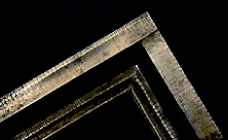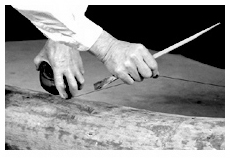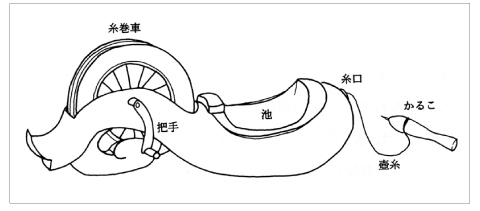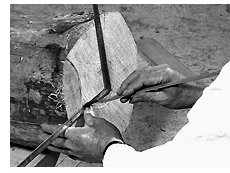Marking Tools [sumikake-dougu]
Sumikake-dogu
Sumikake-dogu

The ink pot is used to draw a long straight line on the surface of wood and other materials accurately. One end of the pot thread is tied to "Karuko", the other is passed through a pond filled with ink juice, and wrapped around a spinach car (see figure). Ink soup is soaked in cotton and put in a pond, and silk thread is used for pot thread.
To use it, hold the ink pot on the left hand and stick the needle of "Karuko" to the material to fix one of the jar threads. When the thread of the required length is rolled out, stop the car rotating with the thumb, press the thread to the required position with the index finger to make it nervous, pinch the thread straight with the right hand and release it. By using the elasticity of the thread in this way, it is possible to draw an accurate straight line regardless of the origin of the material.

Keyaki is mainly used for the material of the ink pot, and the thread is reinforced with pottery and brass. In the past, it was handmade by users, but now it is often made by specialized craftsmen, and there are plastic products. There are various shapes, and some are elaborate, such as sculptures. There are some cars with a handle or not, and carpenters in Kansai mainly use a hand-free format that rotates the car by hand and wraps the thread, and carpenters in Kanto prefer a handle.
A pigment that uses a red shell instead of ink soup is called a red pot. Since the red shell disappears when washed with water, it is mainly used for inking when using natural trees such as polished logs without shaving the bark.

Names of each part of Sumibo
Ink shashi has a spatula on one end and a thin stick on the other side. Use the line on the spatula side with ink juice and the symbol or character on the stick side. It is used together with ink pots and vermilion pots.
The material is made of bamboo. The spatula-like side is thinly interrupted vertically to a depth of about 10 to 15 mm wide and about 1 to 2 cm from the tip, and the spatula tip is cut off diagonally. Draw a line along this part along the kushaku, etc. Skilled people say that interrupts are extremely thin to about 30 to 40 sheets.

Yatate is a small portable brushcase. It consists of an ink that stores ink, and a pole that stores brushes. It may be used in place of ink, such as when numbering.

Various types of Yatate
Basic information
Special Exhibition
Permanent exhibition